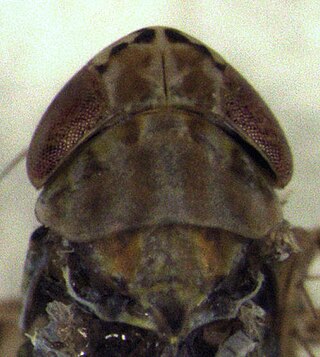
Delphacidae is a family of planthoppers containing about 2000 species, distributed worldwide. Delphacids are separated from other "hoppers" by the prominent spur on the tibia of the hindleg.

Dichomeris is a genus of moths in the family Gelechiidae erected by Jacob Hübner in 1818.

Platypleura is a genus of cicadas that occurs widely across Africa and southern Asia. Some of the South African species are remarkable for their endothermic thermoregulation that enables crepuscular signalling, an adaptation that reduces risk of predation and enables a greater range for their calls. In field experiments their maximum body temperature while calling at dusk, was measured at 22 °C above ambient temperature.

The Thyatirinae, or false owlet moths, are a subfamily of the moth family Drepanidae with about 200 species described. Until recently, most classifications treated this group as a separate family called Thyatiridae.

Maiestas is a genus of insects in the family Cicadellidae, the vast majority of which were formerly placed in the genus Recilia.

Lymantria is a genus of tussock moths in the family Erebidae. They are widely distributed throughout Europe, Japan, India, Sri Lanka, Myanmar, Java, and Celebes. The genus was erected by Jacob Hübner in 1819.

Tanna is a genus of cicadas from Southeast Asia and East Asia. In 2010 Lee and Hill placed Tanna in the subtribe Leptopsaltriina, which is now in the tribe Leptopsaltriini together with a number of related genera that also possess abdominal tubercles, including Leptopsaltria, Maua, Nabalua, Purana, and others.

Cercopidae are the largest family of Cercopoidea, a xylem-feeding insect group, commonly called froghoppers or spittlebugs. They belong to the hemipteran suborder Auchenorrhyncha.

Euterpnosia is a genus of cicada native to the island of Formosa, the Ryukyu Archipelago, Japan, Hainan and mainland Asia - China, Bhutan, Nepal and Vietnam. The type species is Euterpnosia chibensisMatsumura, 1917. Until 2013 this genus was placed in the subtribe Leptopsaltriina, but is now considered typical of the Euterpnosiina Lee, 2013.

The Dundubiini are a tribe of cicadas in the family Cicadidae, found in the Palearctic, Indomalaya, Australasia, and the Western Pacific. There are at least 180 described species in Dundubiini.

Lepyronia is a genus of froghoppers in the family Aphrophoridae.

Calaphidinae is a subfamily of aphids in the family Aphididae. There are more than 60 genera and 360 described species in Calaphidinae.

Gergithus is a genus of planthoppers in the family Issidae. Like all planthoppers, adults feed on plant sap and are capable of escaping by leaping. The genus like other members in the tribe appears somewhat rounded and beetle-like, in some cases, with a mimetic resemblance to ladybird beetles. About 60 species are known in the genus and they are distributed in the Indomalayan and Palearctic Realms.

Aphrophora is a genus of spittlebugs in the family Aphrophoridae. There are at least 80 described species in Aphrophora.

Notocomplana is a genus of flatworms. It is the only genus in the monotypic family Notocomplanidae.

Sylvicola is a genus of wood gnats in the family Anisopodidae. There are more than 80 described species in Sylvicola.

Dictyophara is the type genus of planthoppers belonging to the family Dictyopharidae and tribe Dictyopharini, containing five subgenera. The scientific genus name Dictyophara derives from the Greek and can be translated "who wears a net".
Macrosemia is a genus of Asian cicadas in the tribe Dundubiini. Species records are from Taiwan and the eastern Asian mainland, including Indo-China.
Miphora is a genus of true bugs belonging to the family Aphrophoridae.
















